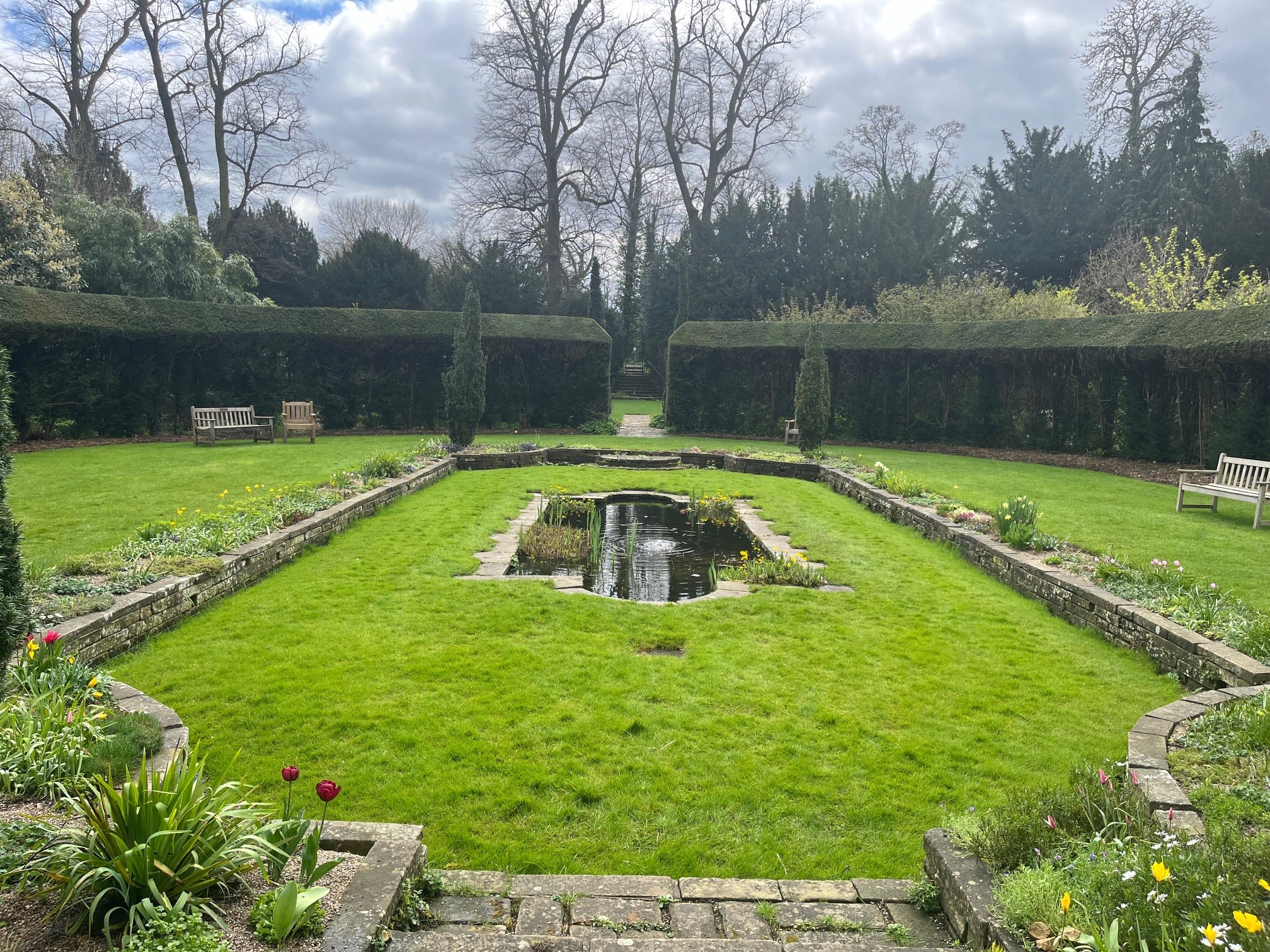Fellows' Garden Reopens

After what felt like four-hundred and thirty-six bleak years (I jest, ‘twas only four, but I know it felt like longer for many), the Fellows’ Garden finally reopened for College members to enjoy over the Easter weekend. Most of the current student body have not had the pleasure of relaxing/ studying in it, and there are a fair few staff and Fellows who have no idea of the little slice of heaven that lies on the other side of the Avenue.
In the ‘before-times’, one could expect to find: exquisite, sweeping, herbaceous borders, filled to the brim with an array of perennials in every colour imaginable; hidden in the centre, a serene sunken garden in pastel colours and a pond with a gently bubbling fountain, creating a wonderfully calm environment away from the hustle and bustle of College life; a tropical garden with our famous bananas, among other delights, which comes into its own by the end of the summer as it has had all season to grow lush foliage; a long, double-sided herbaceous border consisting of yellow and blue flowers only, which puts emphasis on the original garden designer (and Fellow) Nevill Willmer’s research on colour perception; and the Dean’s Walk which meanders between a row of large yew trees and a wall the length of the entire garden, with white-flowering plants of many different genera.
In March 2020 the country went into its first lockdown and in June 2020 work began on creating an access route through the Fellows’ Garden from the Backs, and stripping out both the Master’s and Fellows’ Gardens to become building sites. Turf, soil and plants were taken out, and rubble, hard-core, temporary bridges and cranes were brought in. These were difficult times for the gardeners: not only because Covid-19 prevented them being onsite, unable to care for the areas left untouched by the building works, but also to see the paradise into which we had poured blood, sweat and tears for decades ripped out and replaced by a desert of hard-core with industrial machines constantly whizzing back and forth.
However, the ever-determined gardeners would not be beaten, and are rising to the challenge of restoring the gardens back to their former glory. Much work has been going on behind the scenes, not least designing and implementing a new ‘dry border’ for the river beds — thinking ahead and future-proofing the planting to cope with the hotter, drier summers we now have due to climate change. Ironically, as we have seen, this may also mean heavier and more frequent winter rain! We have used left-over builder’s rubble at varying depths to plant in, making some areas completely soilless. In doing this, we join a movement that has seen high-profile gardens countrywide rip up the rule book – with great success. The plants will grow smaller and tougher, requiring less water and fertiliser, while also being less labour intensive.
Reinstating the mixed border from scratch is no mean feat either. By using plants saved from the builders and stored in temporary nurseries, splitting large clumps of perennials from our other gardens, and some generous plant donations from neighbouring colleges, we have managed to fill the length and breadth of the Mixed Border once more and we are very excited to see the results come early summer.
The Yellow & Blue Borders and the Sunken Garden have had their renovation dig-through, and although they may all be a little sparser than normal, they will be beautiful nonetheless.
We are also looking forward to planting up the Tropical Garden again, creating our own little jungle in the centre of Cambridge.

Alas, it is never plain sailing when reinstating beautiful gardens on such a large scale. The large expanse of lawn has been subject to extensive flooding since the reinstatement works, and some areas have been under water since October as the rainwater is unable to drain away. The College has commissioned a report from a soil specialist to determine the cause and provide a remedy. In the meantime, however, this does mean we’ve had to put restrictions on usage until we can implement a solution. We may have to rope it off from time to time after adverse weather until we can rectify the issue.
Gardens need time to recover and we would do well not to forget that they are living structures and spaces that need constant attention. Once the gardens are open again you will undoubtedly see us gardeners working away in the background. Do come up and say ‘Hi’ and ask us any questions that you may have (any excuse to give the old back a good stretch). We’ve still a way to go but we are certainly getting there. It will be a pleasure to share the gardens with you all again and we can watch it mature and grow together.

